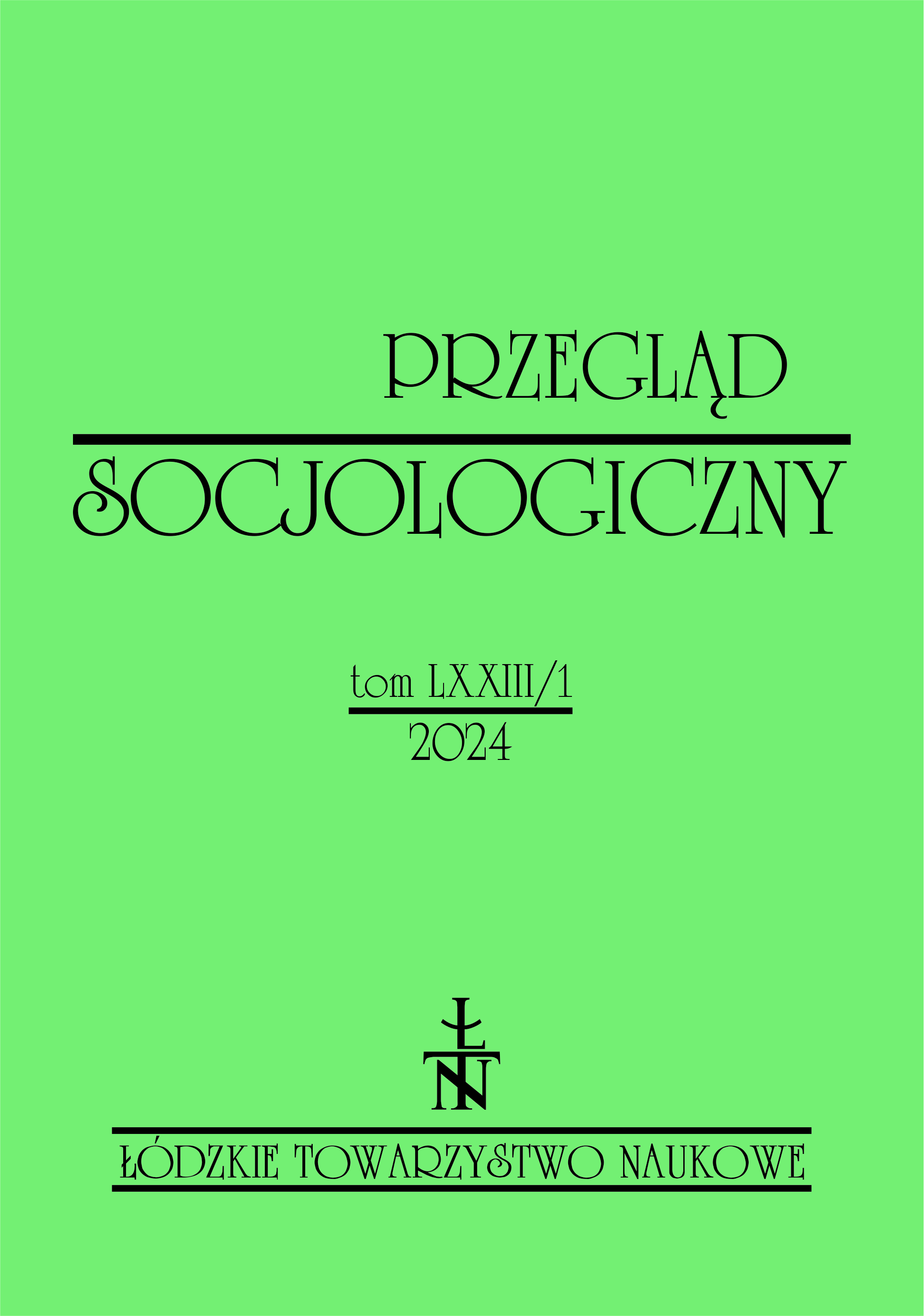Watching movies from the perspective of social class divisions
DOI:
https://doi.org/10.26485/PS/2024/73.1/4Keywords:
watching movies, cultural stratification, lifestylesAbstract
In this article we explore empirically how taste for films relates to social class, i.e., how preferences for particular films depend on patterns apparent in other dimensions of lifestyle. Drawing on a survey of cultural activity in Poland (n = 2007) carried out in 2019, we test three hypotheses concerning: (i) the effect of social class on film tastes, (ii) the homology of (or the correspondence between) the space of cultural goods and the space of social positions, and (iii) to what extent preferences for films relate to participation in other dimensions of cultural activity. The results show that tastes for films are weakly connected with class divisions. This is in line with the quasi-homology explanation, which holds that the effect of class position is negligible. As regards links between liking film and genres in other areas of culture we find that preferences for films transfer mostly to watching TV series. They are weakly connected to reading books, liking classical music, or going to the theatre. Taken together, our findings suggest that watching films has not, up until this point, contributed strongly to the consolidation of class structure in Poland.
References
Barnett A. Lisa, Michael P. Allen. 2000. “Social class, cultural repertoires, and popular culture: The case of film”. Sociological Forum 15(1): 145–163. https://doi.org/10.1023/A:1007502405539.
Bartosiewicz Aleksandra, Agnieszka Orankiewicz. 2019. „Współczesny rynek dystrybucji kinowej w Polsce”, Kwartalnik Filmowy 108: 232–242. https://doi.org/10.36744/kf.197.
Bennett Tony, David Wright, Modesto Gayo-Cal, Elizabeth B. Silva, Mike Savage, Alan Warde. 2009. Culture, class, distinction. London–New York: Routledge.
Bihagen Erik, Tally Katz-Gerro. 2000. “Culture consumption in Sweden: The stability of gender differences”. Poetics 27: 327–340. https://doi.org/10.1016/S0304-422X(00)00004-8.
Bourdieu Pierre. 2022. Dystynkcja. Społeczna krytyka władzy sądzenia. Warszawa: Wydawnictwo Naukowe Scholar.
CBOS. 2023. Aktywności i doświadczenia Polaków w 2022 roku: Komunikat z badań. https://www.cbos.pl/SPISKOM.POL/2023/K_018_23.PDF [dostęp: 15.08.2023].
Cebula Michał. 2019. „Poza klasą społeczną i statusem. Sieciowe zakorzenienie konsumpcji muzyki”. Przegląd Socjologiczny 68(2): 81–105. https://doi.org/10.26485/PS/2019/68.2/4.
Coulangeon Philippe, Julien Duval. (red.). 2015. The Routledge companion to Bourdieu’s “Distinction”. London: Routledge.
Crane A. Susan. 2000. Museums and memory. Stanford: Stanford University Press.
Domański Henryk, Dariusz Przybysz, Katarzyna M. Wyrzykowska, Kinga Zawadzka. 2021. Dystynkcje muzyczne. Stratyfikacja społeczna i gusty muzyczne Polaków. Warszawa: Wydawnictwo Naukowe Scholar.
Domański Henryk, Dariusz Przybysz, Katarzyna M. Wyrzykowska, Kinga Zawadzka. 2023. „Seriale telewizyjne a dystanse klasowe w Polsce”. Studia Socjologiczne 1(248): 115–143. https://doi.org/10.24425/sts.2023.144836.
Gałuszka Mieczysław. 1984. „Potoczne odtworzenie filmu”. Studia Socjologiczne 4: 161–184.
Gałuszka Mieczysław, Kazimierz Kowalewicz. 1977. „Szkic do badań potocznego odbioru filmu”. Kino 11: 29–31.
Gałuszka Patryk, Katarzyna Korzeniewska, Katarzyna M. Wyrzykowska, Aleksandra Jagiełło-Skupińska. 2013. Rynek fonograficzny w Polsce 2011/2012. IMiT, POLMIC, Warszawa.
Gans J. Herbert. 2012. “Against culture versus structure”. Identities 19: 125–134. https://doi.org/10.1080/1070289X.2012.672850.
GUS . 2019. Kultura w 2018 roku. https://stat.gov.pl/obszary-tematyczne/kultura-turystyka-sport/kultura/kultura-w-2018-roku,20,2.html [dostęp: 15.08.2023].
Erikson Robert, John H. Goldthorpe. 1992. The constant flux: A study of class mobility in industrial countries. New York: Oxford University Press.
Halle David. 1993. Inside culture: Art and class in the American home. Chicago: University of Chicago Press.
Hanchard Matthew, P eter Merrington, Bridgette Wessels, Simeon Yates. 2019. “Exploring contemporary patterns of cultural consumption: Offline and online film watching in the UK ”. Emerald Open Research 1: 16. https://doi.org/10.35241/emeraldopenres.13196.1.
Jarness Vegard, Sam Friedman. 2016. “«I’m not a snob, but ...»: Class boundaries and the downplaying of difference”. Poetics 1259: 1–12. https://doi.org/10.1016/j.poetic.2016.11.001.
Pedersen Willy, Vegard Jarness, Magne Flemmen. 2018. “Revenge of the nerds: Cultural capital and the politics of lifestyle among adolescent elites”. Poetics 70: 54–66. https://doi.org/10.1016/j.poetic.2018.05.002.
Kaczmarek Jerzy. 2014. Zobaczyć społeczeństwo. Film i wideo w badaniach socjologicznych. Poznań: Wydawnictwo Naukowe UAM .
Kantar Millward Brown. 2018. Widz kinowy w Polsce. Raport z badania przeprowadzonego dla Filmweb sp. z o.o. https://pisf.pl/wp-content/uploads/migrated/dokumenty/Raport_widz_kinowy_2018/Filmweb_raport_widz_kinowy_w_Polsce_2018.pdf [dostęp: 15.08.2023].
Kauftantzoglou Roxanne, Dimitris Emmanuel. 2016. “Social stratification and cultural consumption: Cinema going and choice of movie genres in Athens”. The Greek Review of Social Research 146: 115–152. https://doi.org/10.12681/grsr.10647.
Lissowski Grzegorz, Jacek Haman, Mikołaj Jasiński. 2008. Podstawy statystyki dla socjologów. Warszawa: Wydawnictwo Naukowe Scholar.
Lizardo Omar. 2006. “How cultural tastes shape personal networks”. American Sociological Review 71: 778–807. https://doi.org/10.1177/0003122406071005.
Michael Janna. 2017. “Highbrow culture for high-potentials? Cultural orientations of a business elite in the making”. Poetics 61: 39–52. https://doi.org/10.1016/j.poetic.2017.01.002
Prieur Annick, Lennart Rosenlund, Jakob Skjott-Larsen. 2008. “Cultural capital today: A case study from Denmark”. Poetics 36(1): 45–71. https://doi.org/10.1016/j.poetic.2008.02.008.
Rosenlund Lennart. 2019. “The persistence of inequalities in an era of rapid social change. Comparison in time of social spaces in Norway”. Poetics 74: 101323. https://doi.org/10.1016/j.poetic.2018.09.004.
Towse Ruth. 2011. Ekonomia kultury. Kompendium. Warszawa: Narodowe Centrum Kultury.
Vandebroeck Dieter. 2017. Distinctions in the flesh: Social class and the embodiment of inequality. London: Routledge.
Wejbert-Wąsiewicz Ewelina. 2018. „Socjologiczne widzenie filmu i kina”. Przegląd Socjologiczny4: 141–169. https://doi.org/10.26485/PS/2018/67.4/7.
Downloads
Published
How to Cite
Issue
Section
License
Copyright (c) 2024 Łódzkie Towarzystwo Naukowe

This work is licensed under a Creative Commons Attribution 4.0 International License.



